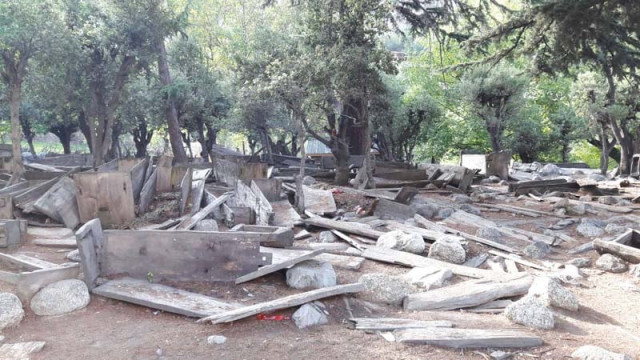Transition: Moving from one existence to the next
No less intriguing are the last rites of the Kalash people

Graveyard in Kalash Valley. PHOTOS: YUSRA HAYAT/EXPRESS
No less intriguing are the last rites of the Kalash people residing in Bumboret, Rumbur and Birir valleys in Chitral. Locals perform similar rituals when bidding adieu to loved ones who are about to embark upon their very own journey through the afterlife.
The graveyard in Karakal village in Bumboret Valley does not have any boundaries marking the enclosure save some trees which are venerated due to their presence in the vicinity.
Last rites
The body of the deceased is brought to the graveyard on a charpoy and placed in a wooden coffin-like box. Similar to customs of ancient Egyptians; food, mostly fruits and nuts, war equipment and often vessels, utensils and money are placed in the box containing the body. The people of the valleys believe these are essential items to start the journey into the afterlife.
The box is then left on the premises along with the charpoy which is kept in an inverted position.
However, recently the Kalash community has started to bury their dead. Some people believe this is to create more room at the cemetery, while others say it is to avoid air pollution caused by rotting bodies left exposed to the elements.
“I think people are becoming more educated in this part of the world and now realise the significance of burying bodies rather than leaving them to decay and decompose,” says a tourist from the province, visiting the valleys for the first time.
A Kalash woman from Bumboret, Arab Gul, told The Express Tribune that people in the past probably did not have tools to bury the dead. "Our ancestors either lacked equipment or the knowledge of the process of burial," she said, adding, education definitely played a key role in the concept of burying the dead in the valleys today.
When asked why none of the graves today bore names or birth and death dates of the deceased, Gul said the concept was alien to the people of Kalash even today.
The only grave that bears a name was that of Jordi F Magraner, a slain Spanish zoologist who was working in the area till 2002. "Since he was a practicing Christian and they follow the custom of remembering people by writing their names on graves, people did that for him here," Gul said
Pre-burial ceremony
The people of Kalash blow whistles, sing, dance and beat drums around the body before taking it for burial. They believe Sajigor, the god of death, prefers celebration over mourning at the time of death.
They also prepare lavish meals and feed all guests who come to the funeral to express their solidarity with bereaved family. The affair is expensive and mostly everyone from the community contributes for the occasion.
“Someone brings a goat, others supply sacks of wheat for bread and some provide grapes to make juice from the neighbourhood,” Millat Bibi, a resident of Broon village in Bumboret, tells The Express Tribune.
She adds rituals take place in the open air unless there is rain in which case they are held in the jashtakaan (sacred hall for the dead).
Refuge from rain
An enclosed space reserved for performing rites for the dead, a jashtakaan, is established in every village of each of the three Kalash valleys.
The structure is simple—gates and a few pillars with sacrosanct animals sculpted at the top. People of the valley also scribble graffiti on the walls, symbolising religious traditions of Kalash. “It is to remind people, especially the younger and newer generations of our customs,” Maryam, a resident of Karakal village in Bumboret, reveals. However, a signboard outside the premises forbids scribbling of any sort on the walls of the jashtakaan.

The joy of life
Just as the departure of the soul from this world is celebrated in Kalash, the arrival of new life is also commemorated.
When a pregnant woman’s contractions commence, a female relative of the family, usually the mother or sister, accompanies her to an enclosed space in the community called the Bashalini. However, a woman does not merely give birth there, but is also taken for her own comfort and ease. “This is to ensure a woman is at peace and away from the stress of the world,” Maryam says. She adds a pregnant woman is cared for by other women of the village in the Bashalini.
At least 10 days after a baby is born, the mother leaves the enclosure along with her child with people from the village. On the occasion, songs are sung, drums are beaten and dances are performed. People celebrate the arrival of new life and take part in festivities.
Published in The Express Tribune, August 4th, 2016.













COMMENTS
Comments are moderated and generally will be posted if they are on-topic and not abusive.
For more information, please see our Comments FAQ